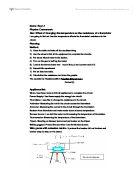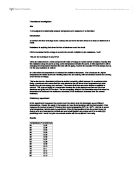Resistance - This is a measure of how hard it is for the electrons to travel through a part of the circuit (measured in Ohms (Ω))
Thermistor: This is the resistor. It measures the resistance of a circuit.
Ammeter: This is used to measure the electrical current through a conductor
Voltmeter: This measures the potential difference between two points in a circuit.
Preliminary experiment:
In order to make sure that my experiment would be as accurate and as successful as it could be I conducted a preliminary experiment. In my preliminary experiment I found out a few potential problems. One of these was the fact that when the temperature of the water passed eighty degrees Celsius it became too high a reading for the ammeter. This meant that I could not take any more readings past that temperature. Also by doing a preliminary I could get used to the apparatus and the real experiment would have been a lot easier.
Prediction: I predict that the temperature will affect the resistance of the thermistor. By using my own background scientific knowledge and all of the results from my preliminary experiment can verify my prediction. I predict that the resistance will decrease with the increase of temperature. I think this not only because of scientific sources but my own.
I predict that the graph will look something like this:
Explanation of prediction:
In my prediction I have stated that a change in temperature will affect the resistance of the thermistor.
In general an increase in temperature increases the resistance of metal but decreases the resistance of semiconductors. The resistance of most thermistors decrease as their temperature rises. In my case the resistance theoretically will in fact decrease as I raise the temperature.
The electrons in the heat energy produce resistance in the electrical circuits. We can measure ho w many electrons have effected the thermistor by measuring the current and the voltage.
Scientific theory
The current and voltage of an electric circuit, is given by the formula V=IR. This is known as Ohms. Ohm´s Law is only applicable, when the temperature of the resistor is kept constant. Therefore Ohms law is only applicable to Ohmic conductors. Examples of Ohmic conductors are metals and alloys at constant temperatures. Anything that doesn’t obey Ohms law, are know as non-Ohmic Conductors. Examples of these are Silicon, and Germanium.
Method:
Firstly I set up all of my apparatus as in the circuit diagram. I then checked that it was all set up correctly before switching it on.
Secondly I placed all of the ice into the beaker with the thermometer and waited until the temperature had dropped to zero degrees Celsius.
When the temperature had dropped to freezing I took my first reading of current and the volts. I then lit my Bunsen burner and began to heat the ice. Throughout the experiment I took eleven readings. I took readings of the milliamps and the volts every 10c until the temperature of the water reached boiling point. Then I had finished the first set of readings I restarted the experiment for a second time in order to average them out for more accurate results.
Results:
Analysis:
The graph and results show that when the temperature increases the resistance decreases. My line of best fit is a curve. This means that the resistance changes with increase in temperature but the curve is not constant. The gradient of my graph a is steep and decreases quickly in the first 30 degrees, but slows down and levels out from 30 degrees to 80 degrees. This is because the resistance of the thermistor decreases at a slower rate. This all corresponds with my explanation of prediction. My graph answers my hypothesis. My graph is not proportional as they do not both increase but increase and decrease.
My prediction says that the resistance will decrease with an increase of temperature I can now verify that with the help of my results and graph.
Evaluation:
In all I think my experiment was very successful. I did not run into any difficulties except for one minor problem. This problem was not picked up in my preliminary experiment but was a factor that affected my main experiment. This problem was that the volt meter was dysfunctional at the temperature of 80 degrees or above. The results I obtained were all of a good quality. I believe they are of good quality as I had just one result that showed up to be out of place. All of the other readings again correspond to my prediction and analysis. The one odd result was probably due to an inaccurate reading of the ammeter or the voltmeter. Although I feel that my experiment was successful if I were to do it again I would change one or two things. One of these things would be repeating the experiment at least five times and finding averages.







